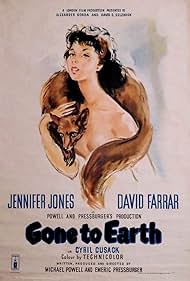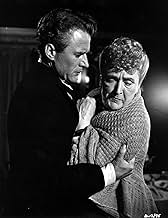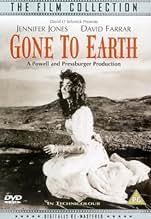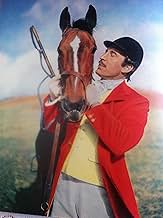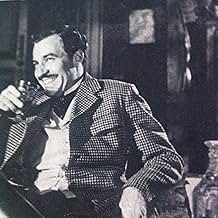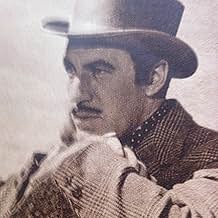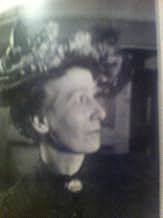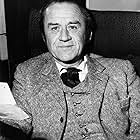IMDb RATING
6.9/10
1.6K
YOUR RATING
A beautiful, superstitious, animal-loving Gypsy is hotly desired by a fox-hunting squire even after she marries a clergyman.A beautiful, superstitious, animal-loving Gypsy is hotly desired by a fox-hunting squire even after she marries a clergyman.A beautiful, superstitious, animal-loving Gypsy is hotly desired by a fox-hunting squire even after she marries a clergyman.
- Awards
- 1 win & 1 nomination
Arthur Mainzer
- Chapel elder
- (as Arthur Reynolds)
- Directors
- Writers
- All cast & crew
- Production, box office & more at IMDbPro
Storyline
Did you know
- TriviaThe choir was the real choir from the local Methodist chapel. When he heard them singing, director Michael Powell said they were too good and he wanted them to sound "more ragged, like a choir of country folk" only to be told "But we ARE country folk, Mr. Powell."
- GoofsAs Abel and Hazel Woodus come down the hill to the chapel, the mine engine house disappears and then reappears between shots
- Quotes
Hazel Woodus: The world wasn't made in seven days only for Abel Woodus.
- Alternate versionsThe reedited and shortened version titled "The Wild Heart" was produced after a disagreement and court case between director Michael Powell and producer David O. Selznick. Selznick's changes are mainly:- (1) Adding a prologue. (2) Adding scenes explaining things, often by putting labels or inscriptions on them. (3) Adding more close-ups of Jennifer Jones (Selznick's wife). He also deleted a few scenes that he felt weren't dramatic enough. Sadly some of these were major plot points so the story doesn't make as much sense as the original. In his autobiographies, Powell claimed that Selznick only left about 35 mins of the original film. In fact there's a lot more than that. About 2/3 of the original remains.
- ConnectionsFeatured in The Late Show: Michael Powell (1992)
Featured review
This was a hard film to see for a very long time, at least in any form that would do it justice. But the small snippets of it I'd caught made me steadfastly wait for the day I could view it, and having done so, I can say it's considerably better than its fairly middling reputation.
Maybe the easiest way to describe it is as Powell & Pressburger's "Wuthering Heights" - it's set in that gothic period drama genre, anyway - but at root it's a grown-up, thoughtful and adult romance-of-sorts set on windswept fairy-tale moors.
The two films it fits closest to in their body of work would be "I Know Where I'm Going" (for the elemental setting) and especially Black Narcissus, for the matchless colour photography and mood of suppressed eroticism bubbling savagely beneath the surface. You can feel the invisible forces of superstition and desire affecting events, the tiny figures swamped by a greater Nature beyond their understanding or powers.
As I've already said, this is a grown-up film, a good 15 years or more before its time in its depiction of adultery and complexity of emotion in a potboiler setting. The sexuality in it is not explicit, but it's firmly engraved in stone between the lines of the script and in small moments of quiet force - flickers of understanding, judgement or confusion passing over every face throughout, speaking volumes.
There's a lurid, hyperreal, almost cartoonishly painterly look to the colour films of the 40s and 50s, which was never seen again afterwards, and is now impossible to recreate. This one has the texture of Singin' In The Rain but is, unusually, set largely outdoors, in the real world, in wide open spaces. Because of this, the nature scenes look, gorgeously, straight out of Bambi.
Gone To Earth is not P&P's greatest film, but it's a real treasure nonetheless. A wild, dark, pagan beauty.
Maybe the easiest way to describe it is as Powell & Pressburger's "Wuthering Heights" - it's set in that gothic period drama genre, anyway - but at root it's a grown-up, thoughtful and adult romance-of-sorts set on windswept fairy-tale moors.
The two films it fits closest to in their body of work would be "I Know Where I'm Going" (for the elemental setting) and especially Black Narcissus, for the matchless colour photography and mood of suppressed eroticism bubbling savagely beneath the surface. You can feel the invisible forces of superstition and desire affecting events, the tiny figures swamped by a greater Nature beyond their understanding or powers.
As I've already said, this is a grown-up film, a good 15 years or more before its time in its depiction of adultery and complexity of emotion in a potboiler setting. The sexuality in it is not explicit, but it's firmly engraved in stone between the lines of the script and in small moments of quiet force - flickers of understanding, judgement or confusion passing over every face throughout, speaking volumes.
There's a lurid, hyperreal, almost cartoonishly painterly look to the colour films of the 40s and 50s, which was never seen again afterwards, and is now impossible to recreate. This one has the texture of Singin' In The Rain but is, unusually, set largely outdoors, in the real world, in wide open spaces. Because of this, the nature scenes look, gorgeously, straight out of Bambi.
Gone To Earth is not P&P's greatest film, but it's a real treasure nonetheless. A wild, dark, pagan beauty.
- MogwaiMovieReviews
- Oct 20, 2019
- Permalink
- How long is Gone to Earth?Powered by Alexa
Details
- Release date
- Countries of origin
- Language
- Also known as
- The Wild Heart
- Filming locations
- Production companies
- See more company credits at IMDbPro
- Runtime1 hour 22 minutes
- Aspect ratio
- 1.37 : 1
Contribute to this page
Suggest an edit or add missing content

